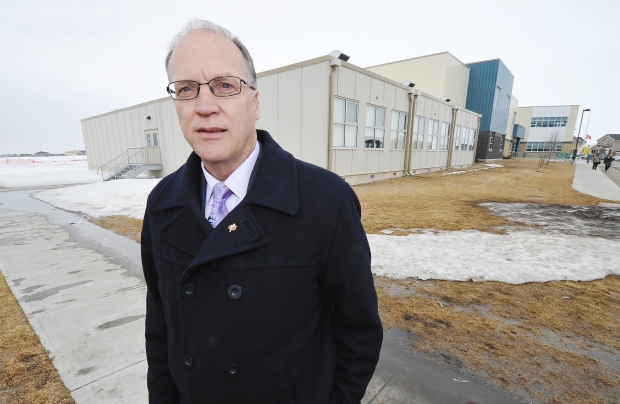EDMONTON – The province has turned down about three-quarters of school-district funding requests this year for new modular classrooms, paying for about 100 of 400 modulars requested to expand Alberta’s overpopulated schools.

However, that’s about twice the number of modular classrooms the government normally approves, thanks to a new deal that has school districts pick up part of the tab, Education Minister Jeff Johnson told a legislature committee in March.
School boards now pay about half the cost of moving and installing the classrooms that are built on to schools — a cost previously covered by the province.
“We’ve come up with a new model this year that we want to try out in terms of delivering modulars and partnering with school boards, where they fund part of the setup,” Johnson said at the March 19 meeting. “By doing that, we believe we’re going to get about 100 modulars out the door … instead of the 45 that we would have.”
School boards still have the option of purchasing more modulars by paying the full cost themselves.
The province has ordered 100 modulars, and most or all of them should be built by September, said Alberta Education spokesman Tim Chamberlin. School districts are then responsible for transporting the classrooms and hooking them up to schools. The total cost to build and install each modular classroom is about $300,000, Chamberlin said.
“We’ll be able to create an additional 2,000 student spaces in the system,” Chamberlin said of the 100 modulars.
“We try to accommodate as many requests as possible … We look at the approvals against a set of criteria to ensure we’re meeting the most pressing needs throughout the province.”
Edmonton Public Schools will get four of the modulars, said Lorne Parker, the district’s managing director of planning, property management and transportation.
Two modulars will be installed at Dr. Donald Massey Elementary Junior High School, at 5435 162nd Ave. in the Hollick-Kenyon neighbourhood.
The other two will be built on to Michael Strembitsky Elementary Junior High School, at 4110 Savaryn Dr., in the Summerside neighbourhood.
“We understand the financial pressures the province is under,” Parker said. “So while we would prefer to see it fully funded, we do accept the model. The fact is that it allows the pressure to be alleviated in a lot of other jurisdictions rather than just a few of them.”
The school district will also spend about $3 million to buy six new portable classrooms — free-standing classrooms that are not built on to the schools — and move eight portables between schools to accommodate students next fall, Parker said.
Six of those portables will expand A. Blair McPherson Elementary Junior High School, at 430 Tamarack Green in southeast Edmonton.
Another six portables will expand space at Dr. Donald Massey to 1,050 students, its maximum capacity. Enrolment there is expected to be about 970 students in September, Parker said.
The remaining two portables will go to the new Michael Strembitsky School, which will be expanded to its 1,000-student maximum in September. It has a projected enrolment of about 933, said Parker.
“We’re feeling enrolment pressure because, as you know, the development continues (in new neighbourhoods).”
Two other schools built in 2010 — Esther Starkman and Johnny Bright schools — were expanded last fall to maximum capacity. That prompted the school district to announce junior high school students in both schools will have to attend elsewhere in September because the schools are too full.
Edmonton Catholic Schools asked for eight new modulars and will receive four, said spokeswoman Lori Nagy. Those will expand Monsignor Fee Otterson School, a K-9 school in the Rutherford neighbourhood, and Monsignor William Irwin School, a K-6 school in Terwillegar Towne.
The district will also move two modulars to William Irwin and buy another two for Fee Otterson, said Boris Radyo, assistant superintendent for educational planning.
In total, Edmonton Catholic Schools will use nearly $1.7 million from capital reserves to buy, move and install extra classrooms, Radyo said.
“We incur additional costs … to build the connecting hallways. In some cases, we’re connecting sewer, water, electricity, gas, utilities to those modular units,” Radyo said.
“Both of those schools will be completely built out to maximum capacity. We don’t think we will be able to add more classroom space to either of those schools.”
That should accommodate student growth for at least the next three or four years, he said.
NDP education critic David Eggen said the province is not keeping up with the exploding demand for school space.
School districts used to handle building their own portables until the government centralized the system, Eggen said. Alberta’s new schools are built on a template that has a central core designed so portables can be added or taken away depending on demand, he said.
“The modular options are key to making this thing work, and it was a total system fail on both modular and portable availability,” Eggen said. “They’re completely unable to meet the needs of these new schools.
“This government seems predisposed to centralization — everything from health care and now post-secondary education — and they should really take a second look at that because when the system does fail, like it has with modulars or portables, the results can be catastrophic. You will not have spaces in these schools in the fall without the modulars and the portables.”


Comments